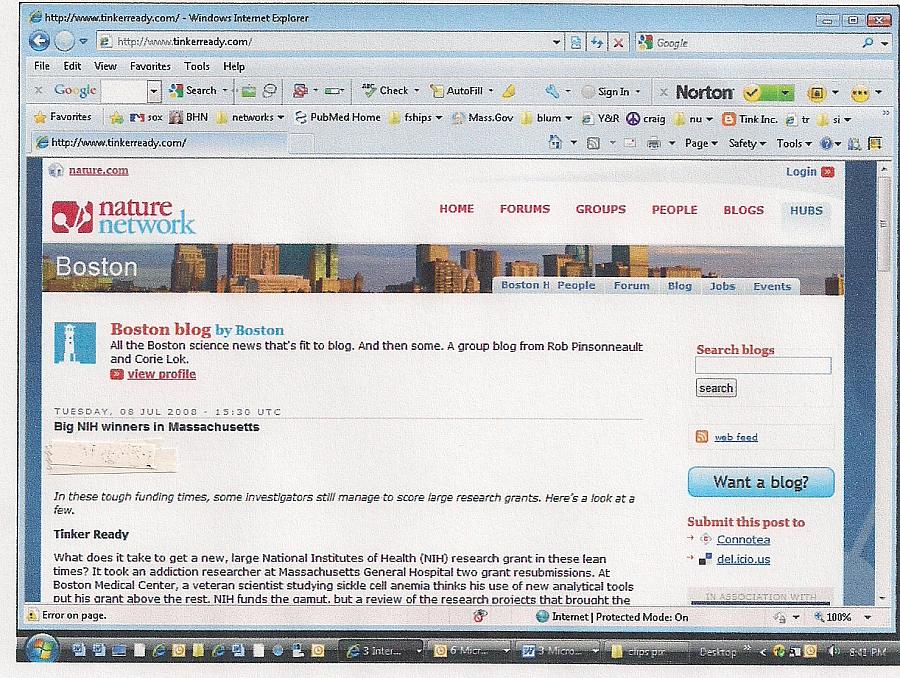Big NIH winners in Massachusetts
What does it take to get a new, large National Institutes of Health (NIH) research grant in these lean times?

What does it take to get a new, large National Institutes of Health (NIH) research grant in these lean times? It took an addiction researcher at Massachusetts General Hospital two grant resubmissions. At Boston Medical Center, a veteran scientist studying sickle cell anemia thinks his use of new analytical tools put his grant above the rest. NIH funds the gamut, but a review of the research projects that brought the most new NIH money into Massachusetts last year finds winners in human genomics, cardiovascular disease, public health, and imaging. Researchers trying to better understand the genetics of diabetes, as well as deadly lung and pancreatic cancers, also did well. In 2007, the NIH awarded more than 5,000 research and training grants to Massachusetts investigators. But only about 350 of those awards were RO1 grants for new, previously unfunded research projects. With a rise in grant proposals and a flat NIH budget, those who won had to stand out from the pack and be persistent. Here is a list showing the 10 largest new RO1 grants for research projects in Massachusetts awarded in 2007, ranked by the amount paid out in 2007. Below are profiles of three of the projects.
--------------------------------------------------------------------------------
Genomic scavenger hunt Sickle cell anemia researcher Martin Steinberg says the subjects of his genome-wide association studies could not be more different, at least on the surface: “Black people who die young and white people who live forever.” But it turns out that genes involved in longevity may also be linked to some cases of sickle cell anemia. So Steinberg, with the Boston University Medical Campus, won $4.4 million last year to do association studies with sickle cell patients and those involved with the New England Centenarian Study, a Boston University cohort who have lived beyond the age of 100. Steinberg’s team hopes to learn more about the genes and pathways involved in both conditions. Studies such as Steinberg’s are part of an NIH-wide push to fund research that tries to identify the genes underlying disease by looking at variations across the entire genome of those with the disease and those without. NIH’s second largest payout of the year in Boston goes to another genome-wide association study–$3.2 million to David Altshuler at Massachusetts General Hospital and the Broad Institute for research on the genetics of early heart attacks. Studies like these are big and expensive—Steinberg’s team will analyze samples from 1,800 sickle cell patients and 1,000 unrelated centenarians—so it’s no coincidence that these sorts of studies end up at the top of the list of the biggest NIH grants. Steinberg has been at the NIH grant game for more than 20 year and considers himself lucky in winning research grant renewals. At the same time, he says recent changes in NIH’s Comprehensive Sickle Cell Center program have led to budget cuts at centers like his.
--------------------------------------------------------------------------------
Getting schizophrenics to stop smoking Until recently, A. Eden Evins, a Harvard psychiatrist and director of the Center for Addiction Medicine at Massachusetts General Hospital, never had to resubmit a grant application to NIH. But she had to revise her proposal on smoking cessation and schizophrenia twice. First submitted in 2005, the proposal finally won the grant that last year brought $812,000 into her program. One reason she thinks NIH finally approved her proposal is that it fits well with current thinking about addiction. “Relapse prevention is really important,” she says. “That is where the money is for addiction treatment.” While 24 percent in the general population smoke cigarettes, between 72 percent and 90 percent of schizophrenics are smokers. Research suggests that smoking improves their cognition, Evins says, which may explain why it’s more difficult for them to quit for good. They relapse at a high rate–about 75 percent after two weeks, compared to 50 percent at one year in non-schizophrenics. The typical treatment program for smokers lasts 8 to 12 weeks but Evins wants to lengthen it to a year for schizophrenia patients and see if that will cut the relapse rate. To test that, she’ll oversee a three-year, multisite, placebo-controlled clinical trial with more than 300 enrollees. After standard treatment of drugs, counseling, as well as a nicotine patch and nasal spray, schizophrenia patients who are not smoking will be randomized to receive the treatment program or a placebo and monitored for relapse. One factor that may have helped her application was an increase in funding for research into tobacco-related diseases at a time when NIH funding for most conditions stayed flat. Also, the application was her first R01–she has since gotten another–and the reviewer noted that Evins was a new investigator. “My sense is that they do cut a break to young researchers,” she says.
--------------------------------------------------------------------------------
Heart surgery from the inside Pierre Dupont, a mechanical engineer at Boston University is developing miniaturized, robotic surgical tools that would enable minimally invasive surgery from within a beating heart. With open-heart surgery, surgeons have more tools at their disposal than if they were doing minimally invasive surgery through tiny incisions, says Dupont. He has teamed up with Pedro De Nido, the head of cardiac surgery at Children’s Hospital Boston, to design steerable instruments that are so small that they can slide through a three-millimeter-wide catheter. With the help of imaging, the surgeon would be able to access the heart’s chambers and make repairs using incisions so small that surgeons wouldn’t need to stop the heart, as they do in open-heart surgery. The goal is to improve dexterity for surgeons while minimizing recovery time for patients. Dupont thinks the collaborative approach he and his research partners are taking helped them win their grant. In addition to De Nido, the team includes engineers at Microfabrica, a California company with the technology to build tiny, complex instruments.

